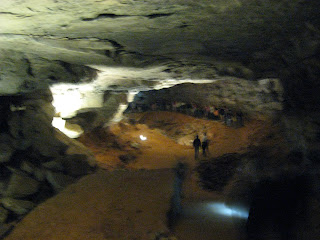365 miles of underground caves! Well, that definitely qualifies as ‘mammoth’. Initially used as an adjective for this huge natural wonder in central
The caves were used by the Native Americans to collect gypsum, which is still abundant in the caves. Mummified Native American bodies were found in the caves. Though these mummies were not as elaborate as the Egyptian ones and the bodies were rather preserved by the caves’ natural conditions. The caves were a prime source for nitrates in the nineteenth and early twentieth century before it turned mostly into a tourist attraction later on. Stephen Bishop, an African-American slave and a guide to the caves during the 1840s and 1850s, is credited to have made extensive maps of the cave, and named many of the cave's features.
However, I must say that the caves are rather featureless. Unless you are an archeologist or some other professional of that sort, you won’t find too much difference in different sections of the caves. There is underground life in the caves such as eyeless fishes and spiders. But they are insignificant. You have to be really watchful to get your eyes on them. The only part of the caves which has any sort of formation is the frozen niagra. It has beautiful arrangements of stalactites.
As for the guided cave tours, consider your physical condition. They might be strenuous if you are not fit because they often involve long walks. However, if you are fit, take the 6 hour wild cave tour (where you are supposed to have real expedition experience) and the frozen niagra tour. There is no point taking all the tours because, as I said earlier, the caves are not very different from one point to the other.
The national park also has some beautiful trails through the forest on the surface. You can also do some kayaking on the river. The camping grounds are decent and pretty cheap ($20/person/night). There is also a Mammoth Hotel with accommodation available. This was my first camping experience. It was pretty good. A tent, a temporary bed, some food, a few friends, man-made restrooms in the vicinity - it all made a perfect camping prospect. Getting the fire on (I mean the real fire, the camp fire) was a different story. It took us quite some effort to get a good fire. Remember, putting up a fire is not easy. We had to try so hard with our gas lighters, kerosene, dry woods bought from the near-by store, magnesium flares and a coal starter from walmart, I wonder how the early humans ever managed it.





















